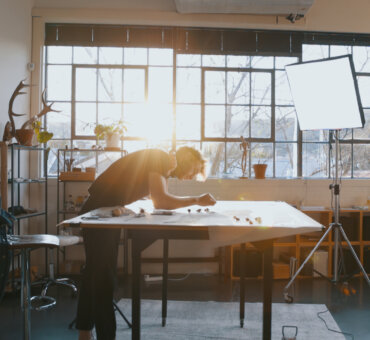In Episode 3 of YouTube Masters, Satchell Drakes, who has worked with brands like Nintendo, Nike, and eBay, (not to mention was also a YouTuber on the board of the Internet Creator’s Guild), talks about how empathy for your viewers is the driving force behind impactful and effective communication.
Read along to discover Satchell’s insights into how to make your audience feel like you truly care.
Here’s Satchell.
Have you ever tried looking up a recipe, or a tutorial, and after two minutes pass, you find yourself needlessly scrolling through an entire blog, just to find the section that pertains to what you Googled?
It’ll say, How to Make Authentic Butterbeer at the top. All you’re doing is reading through seemingly endless ads and an account of the author’s Sunday brunch date with their friend that inspired their epiphany to make butterbeer. And you’re like, “Why is the internet like this?” Did you find what you needed? Eventually.
My name is Satchell Drakes and I make things for a living. I was a host with Forbes for their Games and Sciences department, a YouTuber on the executive board of the Internet Creator’s Guild with Hank Green. I’ve been fortunate enough to pursue my dream of being a designer, a filmmaker, and an online creator. It’s put me in a position of working with teams that were, from childhood, instrumental in forming my imagination.
Empathy for the Viewer
Deriving great joy from being visually-oriented and executing photography-centered things. It should come naturally to want to share ways to get the crispest image. But in truth, what’s been the most invaluable centerpiece to all of these cosmetic components is empathy for the viewer. I feel empathy is the driving force of communicating well because you begin everything in the shoes of the people you’re talking to.
If you don’t have that, you don’t have your audience, and no one is going to make you care about them. But, if you do, it’s hard for people to not take notice. The algorithm for whatever platform you’re presently on is constantly changing and doesn’t care about you. It cares about getting the highest CPM for a tech monopoly’s bottom line. That isn’t top-secret knowledge.
You can do your best to play ball with the cat-and-mouse chase. Humans are platform agnostic and data is cold in a way that people are not. If the people on the receiving end care about you, they’ll follow you to any platform. This is fairly evidenced in traditional media. It’s the difference between having a viral video and a communal channel.
Sense of Place
There’s only one thing algorithms across the board reward — that’s worth caring about anyway — and that’s viewer retention, which is how long someone constantly watches something. Don’t make them jump around or even have to touch the play bar. Try in your outline to develop cadence around the cards that will help people know where they are. Overlays with chapter markers, even adding an hourglass countdown would be pretty rad.
At some point, I learned that we never lose out by making what we have to share painstakingly clear to the viewer. Unless we’re telling a poetic story or conveying fine art in some intentionally indirect way, relentlessly scrutinizing the parts of your script that meander or may cause someone to tap their foot tends to be a net positive.
We have three opportunities to do it, and really, all three are worth it. It’s before, during, and after. Before with a chapter marker or a preface, during the actual explanation, and after, in a conclusion where we can remind people why we’ve arranged our video essay the way that we’ve arranged it.
If you like deeper reading material, William Strunk and E.B. White’s The Elements of Style is a skinny book that will help you out a lot. Here’s the incentive, if you’re straight-forward about your content, you can be straight-forward about asking for likes, subscribes, and bell clicks and people will take you on it.
For two reasons, one — you gave them what they needed upfront, which, people like. A two — you gave them what they needed upfront, so you have their attention and time to ask for favors.
Here’s the incentive, if you’re straight-forward about your content, you can be straight-forward about asking for likes, subscribes, and bell clicks and people will take you on it.
Creative Confidence
I’d like to talk about the media kit for just a second. That’s the splash intro, the logos, the transitions, the credits. There’s a beauty in the restraint required to know you have something strong. There’s strength in keeping intro and splash stuff to a minimum if you’re not making a Saturday morning cartoon-type show.
A general principle I use to keep in check is to let the concise messaging of what you’re communicating be what you show off more than an exhaustive media kit.
Here’s the YouTube grid as it stands. Here’s all the space that your work can occupy. I want to break that down to the essentialist elements here. As far as design goes, I find it’s important to lean into color theory to both get attention, but also to let your people know where you are.

For YouTube, color blocking is your best friend. Neon colors stick out. Coordinate shows with specific colors and typefaces. Play to the environment that you’re in. You could call this gaming the system, but I call it using your eyes. This is the playground everyone’s in. I’m not saying make your thumbnail something problematic with a caps-lock title.
These are four accessible zero-dollar means of making something that people can gather around. These are the things that I find valuable. They’re not as tantalizing as buying a lens — I’ve bought too many lenses and none of them come before knowing your people.
I don’t naturally lean into confidence, and I’m very inclined towards overwhelming people with caveats, such as, “Take this with an eighth of a grain of salt”, or “This might not be your use case per se”, and so on. I think I’m going to leave that discernment on you to decide what should be taken and what should be left.
If you check out my YouTube channel, you’ll likely find that I’ve failed to follow each one of these tenants. At least once, and that’s the point. I tinkered and I Ianded here, and you will tinker and land exactly where makes sense for you. Those are my caveats, that’s my permission, go out there and be merry.
If you liked this article with Satchell Drakes, check out our second episode of YouTube Masters where we chat with Becki and Chris on how to tell a story. And to see more episodes like this, make sure that you subscribe to our YouTube channel.




















































































